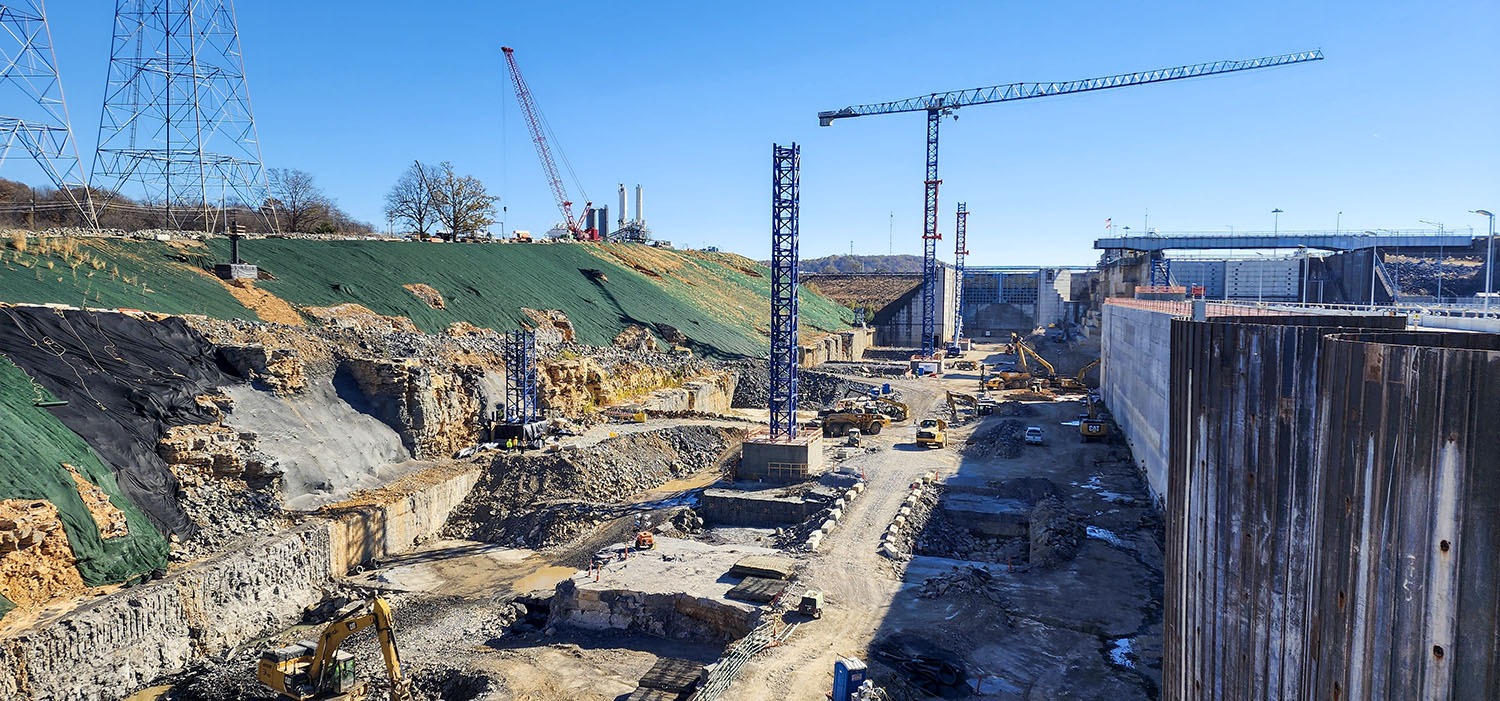The first permanent concrete for the base of the foundation of a new lock chamber at Kentucky Lock was scheduled to be poured December 15, marking a major milestone for project.
The Kentucky Lock Addition Project, being completed in partnership with the Tennessee Valley Authority, will add a second lock at the dam, located at Tennessee River Mile 22.4 in Gilbertsville, Ky. The facility is owned by TVA, but the Corps of Engineers operates and maintains the locks.
Work at the decades-long project is divided into multiple contracts. The upstream cofferdam was completed as one of those contracts in 2006. Downstream lock excavation was completed as part of another contract in October 2022. Highway and utility relocations were also necessary, as U.S. 62 formerly ran across the top of the dam, along with a railroad and utility lines.
“We are now focusing on one major contract, which is our downstream monoliths contract,” said Adam Walker, chief of the project delivery section for the Nashville Engineer District, as part of an update he provided during the Inland Waterways Symposium in Paducah, Ky., earlier this month.
The $380 million downstream monoliths contract was awarded September 30, 2021, to Thalle Construction. The contract originally anticipated access to the cofferdam work area in November 2022; however, collaboration between the Corps and contract partners resulted in early access on July 6, Walker said. The downstream monoliths contract has an estimated completion date of May 16, 2027.
“We’ve been working on this project a couple of decades now beginning with TVA transmission tower relocations in 1998; the end is, hopefully, in sight,” Walker said.
The project creates a new 110- by 1,200-foot lock–double the length of the existing 110- by 600-foot lock. It is expected to eliminate the 10-12 hours of delays that are occurring on average for tows waiting to lock through, Walker said.
The contractor recently completed construction of a concrete batch plant on-site and has completed uniformity testing meant to ensure the plant can consistently produce high-quality concrete, Walker said. Tower cranes have also been erected at the site to support the elevated conveyor belts that will deliver the concrete from the batch plant to the lock location.
“That will be the first concrete that actually covers the rock foundation and gives us a nice, level platform to start building the main lock chamber structure on, so I’m excited to see all that work happening on-site,” he said.
Once the downstream monoliths contract is complete, the lock operational contract is expected to be awarded in fiscal year 2025 and to be completed in September 2030, Walker said.
A team is working to develop the lock operational contract, including advanced coordination with contracting officials designed to bring the new lock on-line as quickly as possible. The scope includes approach walls, electrical/mechanical work, buildings, bridges and utilities.
The lock can be opened before the finishing work is complete, however. The estimated timeframe for the new lock chamber to become operational is in July 2029, Walker said.
While it was originally believed that funding from the Infrastructure Investment and Jobs Act would fund the project to completion, new estimates completed this year showed more funding is needed.
The total project cost is now estimated at $1.56 billion. With allocations of $1.229 billion so far, $332 million is the amount of funding still needed, Walker said.
Existing funding is expected to carry the project until fiscal year 2025, when $75 million would be needed to continue on-site construction through award of the follow-on contract. Walker said another $168 million is needed for fiscal year 2026 and $27 million in fiscal year 2028 with nothing more needed in fiscal years 2029 and 2030 to complete the project.
While those are today’s estimates, Walker cautioned, however, that increased costs and availability issues with construction labor and supply markets required to complete the remaining scope could impact both the estimated total project cost estimate and the completion schedule.
Caption for photo: A recent photo shows the Kentucky Lock Addition Project. The first permanent concrete for the base of the new lock chamber was scheduled to be poured on December 15. (Photo courtesy of the Nashville Engineer District)




